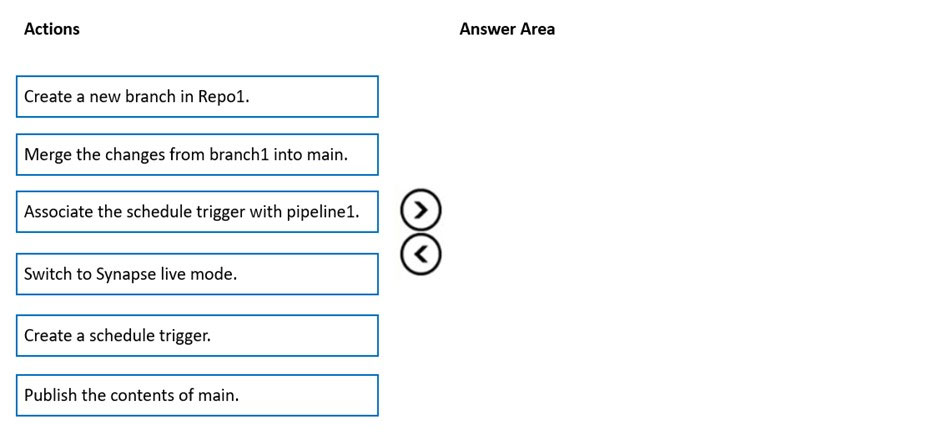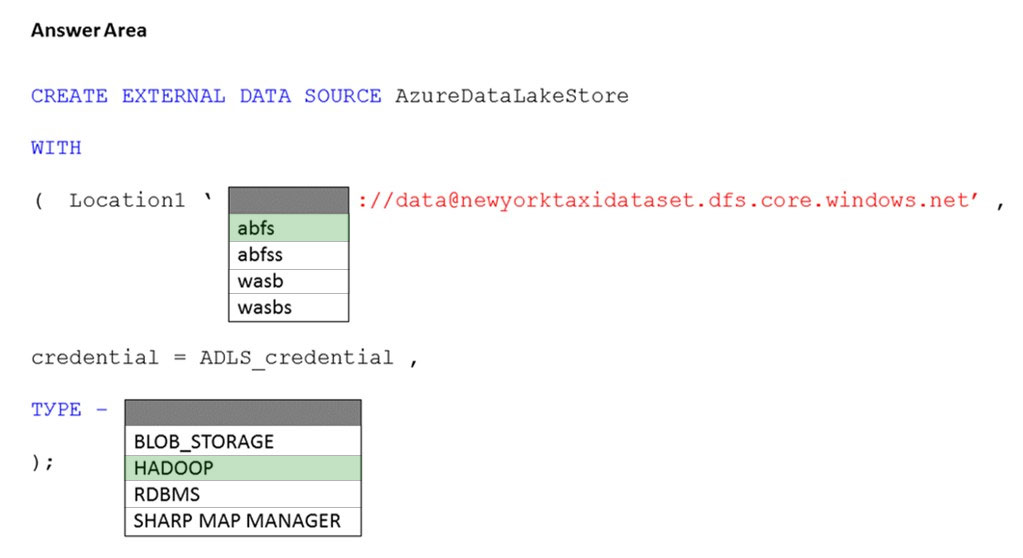You have an Azure data factory named ADF1.
You currently publish all pipeline authoring changes directly to ADF1.
You need to implement version control for the changes made to pipeline artifacts. The solution must ensure that you can apply version control to the resources currently defined in the UX Authoring canvas for ADF1.
Which two actions should you perform? Each correct answer presents part of the solution.
NOTE: Each correct selection is worth one point.
Answer:
BF
Reference:
https://docs.microsoft.com/en-us/azure/data-factory/source-control
DRAG DROP -
You have an Azure subscription that contains an Azure Synapse Analytics workspace named workspace1. Workspace1 connects to an Azure DevOps repository named repo1. Repo1 contains a collaboration branch named main and a development branch named branch1. Branch1 contains an Azure Synapse pipeline named pipeline1.
In workspace1, you complete testing of pipeline1.
You need to schedule pipeline1 to run daily at 6 AM.
Which four actions should you perform in sequence? To answer, move the appropriate actions from the list of actions to the answer area and arrange them in the correct order.
NOTE: More than one order of answer choices is correct. You will receive credit for any of the correct orders you select.
Select and Place:
Answer:

HOTSPOT -
You have an Azure subscription that contains an Azure Synapse Analytics dedicated SQL pool named Pool1 and an Azure Data Lake Storage account named storage1. Storage1 requires secure transfers.
You need to create an external data source in Pool1 that will be used to read .orc files in storage1.
How should you complete the code? To answer, select the appropriate options in the answer area.
NOTE: Each correct selection is worth one point.
Hot Area:
Answer:

Reference:
https://docs.microsoft.com/en-us/sql/t-sql/statements/create-external-data-source-transact-sql?view=azure-sqldw-latest&preserve-view=true&tabs=dedicated
You have an Azure subscription that contains an Azure Synapse Analytics dedicated SQL pool named SQLPool1.
SQLPool1 is currently paused.
You need to restore the current state of SQLPool1 to a new SQL pool.
What should you do first?
Answer:
B
Reference:
https://docs.microsoft.com/en-us/azure/synapse-analytics/sql-data-warehouse/sql-data-warehouse-restore-active-paused-dw
You are designing an Azure Synapse Analytics workspace.
You need to recommend a solution to provide double encryption of all the data at rest.
Which two components should you include in the recommendation? Each correct answer presents part of the solution.
NOTE: Each correct selection is worth one point.
Answer:
BE
Synapse workspaces encryption uses existing keys or new keys generated in Azure Key Vault. A single key is used to encrypt all the data in a workspace.
Synapse workspaces support RSA 2048 and 3072 byte-sized keys, and RSA-HSM keys.
The Key Vault itself needs to have purge protection enabled.
Reference:
https://docs.microsoft.com/en-us/azure/synapse-analytics/security/workspaces-encryption
You have an Azure Synapse Analytics serverless SQL pool named Pool1 and an Azure Data Lake Storage Gen2 account named storage1. The
AllowBlobPublicAccess property is disabled for storage1.
You need to create an external data source that can be used by Azure Active Directory (Azure AD) users to access storage from Pool1.
What should you create first?
Answer:
C
Security -
User must have SELECT permission on an external table to read the data. External tables access underlying Azure storage using the database scoped credential defined in data source.
Note: A database scoped credential is a record that contains the authentication information that is required to connect to a resource outside SQL Server. Most credentials include a Windows user and password.
Reference:
https://docs.microsoft.com/en-us/azure/synapse-analytics/sql/develop-tables-external-tables https://docs.microsoft.com/en-us/sql/t-sql/statements/create-database-scoped-credential-transact-sql
You have an Azure Data Factory pipeline named Pipeline1. Pipeline1 contains a copy activity that sends data to an Azure Data Lake Storage Gen2 account.
Pipeline1 is executed by a schedule trigger.
You change the copy activity sink to a new storage account and merge the changes into the collaboration branch.
After Pipeline1 executes, you discover that data is NOT copied to the new storage account.
You need to ensure that the data is copied to the new storage account.
What should you do?
Answer:
A
CI/CD lifecycle -
1. A development data factory is created and configured with Azure Repos Git. All developers should have permission to author Data Factory resources like pipelines and datasets.
2. A developer creates a feature branch to make a change. They debug their pipeline runs with their most recent changes
3. After a developer is satisfied with their changes, they create a pull request from their feature branch to the main or collaboration branch to get their changes reviewed by peers.
4. After a pull request is approved and changes are merged in the main branch, the changes get published to the development factory.
Reference:
https://docs.microsoft.com/en-us/azure/data-factory/continuous-integration-delivery
You have an Azure Data Factory pipeline named pipeline1 that is invoked by a tumbling window trigger named Trigger1. Trigger1 has a recurrence of 60 minutes.
You need to ensure that pipeline1 will execute only if the previous execution completes successfully.
How should you configure the self-dependency for Trigger1?
Answer:
D
Tumbling window self-dependency properties
In scenarios where the trigger shouldn't proceed to the next window until the preceding window is successfully completed, build a self-dependency. A self- dependency trigger that's dependent on the success of earlier runs of itself within the preceding hour will have the properties indicated in the following code.
Example code:
"name": "DemoSelfDependency",
"properties": {
"runtimeState": "Started",
"pipeline": {
"pipelineReference": {
"referenceName": "Demo",
"type": "PipelineReference"
}
},
"type": "TumblingWindowTrigger",
"typeProperties": {
"frequency": "Hour",
"interval": 1,
"startTime": "2018-10-04T00:00:00Z",
"delay": "00:01:00",
"maxConcurrency": 50,
"retryPolicy": {
"intervalInSeconds": 30
},
"dependsOn": [
{
"type": "SelfDependencyTumblingWindowTriggerReference",
"size": "01:00:00",
"offset": "-01:00:00"
}
]
}
}
}
Reference:
https://docs.microsoft.com/en-us/azure/data-factory/tumbling-window-trigger-dependency
HOTSPOT -
You have an Azure Synapse Analytics pipeline named Pipeline1 that contains a data flow activity named Dataflow1.
Pipeline1 retrieves files from an Azure Data Lake Storage Gen 2 account named storage1.
Dataflow1 uses the AutoResolveIntegrationRuntime integration runtime configured with a core count of 128.
You need to optimize the number of cores used by Dataflow1 to accommodate the size of the files in storage1.
What should you configure? To answer, select the appropriate options in the answer area.
Hot Area:
Answer:

Box 1: A Get Metadata activity -
Dynamically size data flow compute at runtime
The Core Count and Compute Type properties can be set dynamically to adjust to the size of your incoming source data at runtime. Use pipeline activities like
Lookup or Get Metadata in order to find the size of the source dataset data. Then, use Add Dynamic Content in the Data Flow activity properties.
Box 2: Dynamic content -
Reference:
https://docs.microsoft.com/en-us/azure/data-factory/control-flow-execute-data-flow-activity
Note: This question is part of a series of questions that present the same scenario. Each question in the series contains a unique solution that might meet the stated goals. Some question sets might have more than one correct solution, while others might not have a correct solution.
After you answer a question in this section, you will NOT be able to return to it. As a result, these questions will not appear in the review screen.
You plan to create an Azure Databricks workspace that has a tiered structure. The workspace will contain the following three workloads:
✑ A workload for data engineers who will use Python and SQL.
✑ A workload for jobs that will run notebooks that use Python, Scala, and SQL.
✑ A workload that data scientists will use to perform ad hoc analysis in Scala and R.
The enterprise architecture team at your company identifies the following standards for Databricks environments:
✑ The data engineers must share a cluster.
✑ The job cluster will be managed by using a request process whereby data scientists and data engineers provide packaged notebooks for deployment to the cluster.
✑ All the data scientists must be assigned their own cluster that terminates automatically after 120 minutes of inactivity. Currently, there are three data scientists.
You need to create the Databricks clusters for the workloads.
Solution: You create a Standard cluster for each data scientist, a High Concurrency cluster for the data engineers, and a Standard cluster for the jobs.
Does this meet the goal?
Answer:
B
We would need a High Concurrency cluster for the jobs.
Note:
Standard clusters are recommended for a single user. Standard can run workloads developed in any language: Python, R, Scala, and SQL.
A high concurrency cluster is a managed cloud resource. The key benefits of high concurrency clusters are that they provide Apache Spark-native fine-grained sharing for maximum resource utilization and minimum query latencies.
Reference:
https://docs.azuredatabricks.net/clusters/configure.html